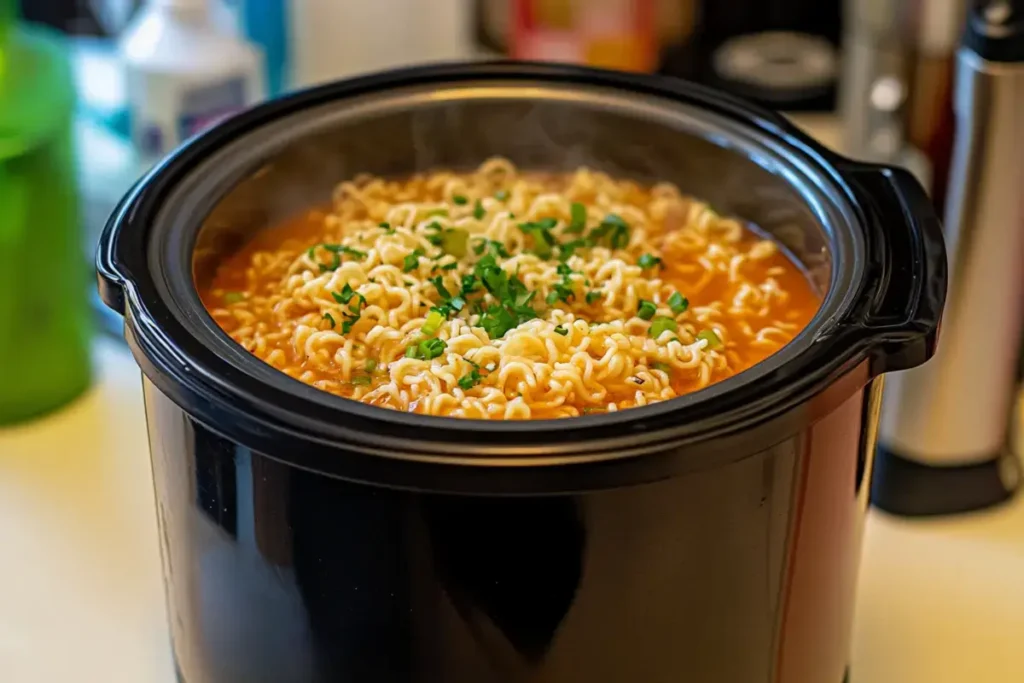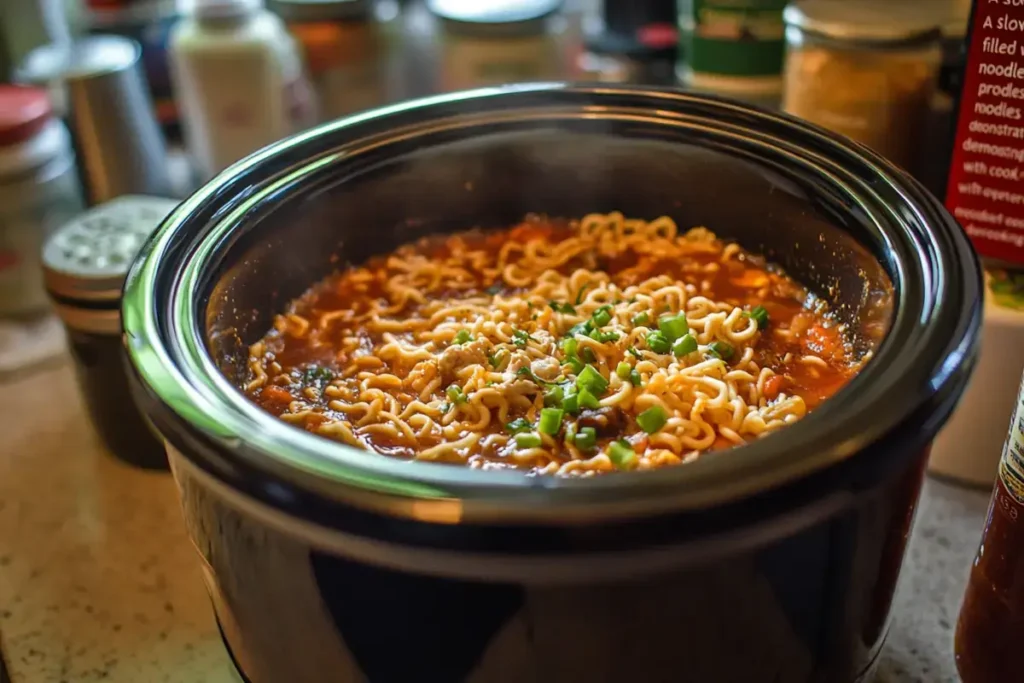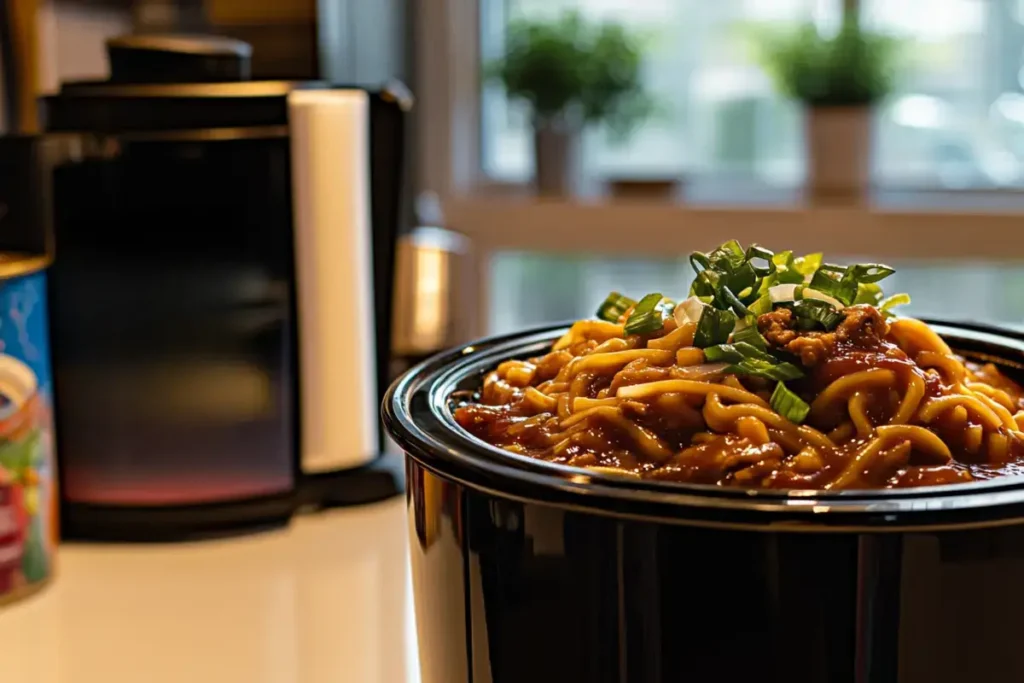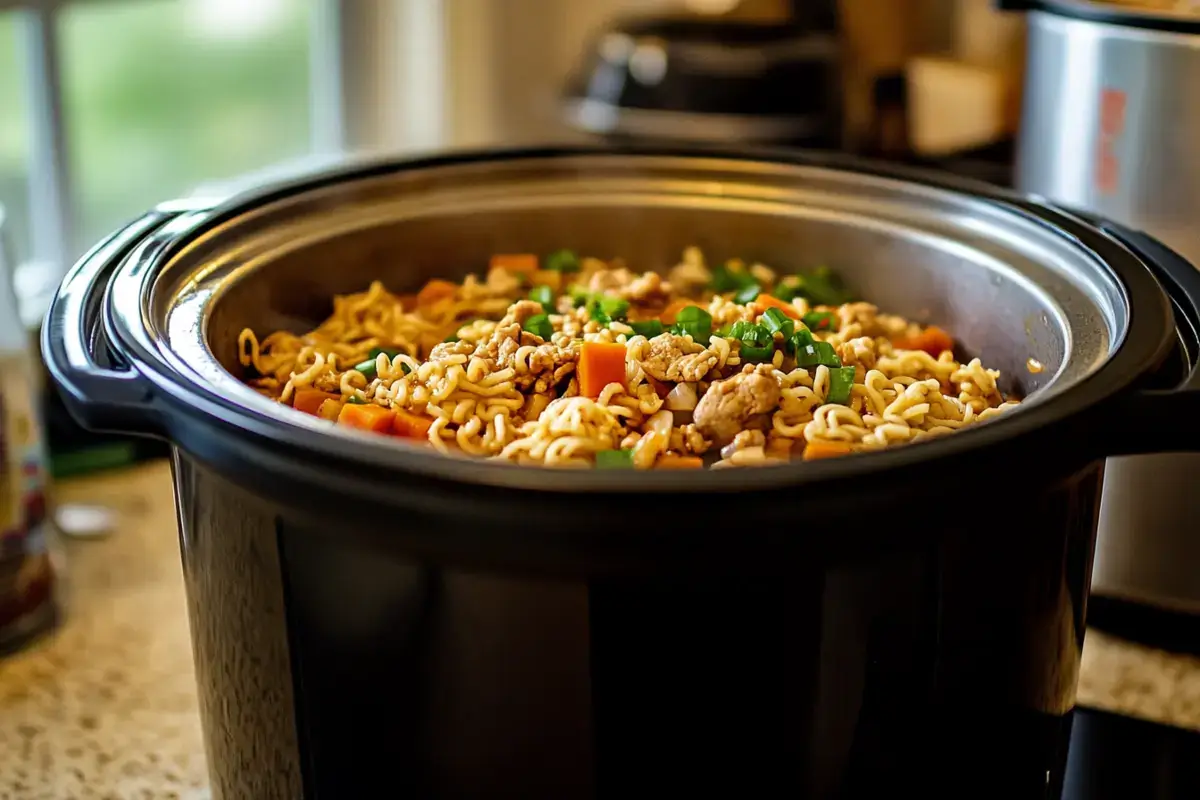Learn how to prepare noodles in your crockpot: tips, timing, and strategies for perfect pasta every time.
Introduction
Many busy home cooks rely on slow cookers for effortless, hearty meals. Accordingly, the question often arises: Can you cook dry noodles in a crockpot? The short answer is yes, although success depends on careful timing, liquid ratios, and ingredient choices. This comprehensive guide walks you through everything you need to know. You will discover the benefits of slow cooking pasta, tips for managing different noodle varieties, and strategies to avoid the dreaded mush. We will also address common mistakes, flavorful pairings, and essential FAQs. By the end, you will feel confident creating easy, comforting pasta dishes right in your crockpot, saving both time and effort while achieving delicious results.
Understanding How Crockpots Work?
Slow cookers, often referred to as crockpots, are designed for low-and-slow heat. They typically have two or three basic settings—low, high, and sometimes warm—to maintain a stable temperature for hours. This gentle cooking environment locks in moisture, allowing ingredients to simmer together gradually. Consequently, flavors deepen, sauces thicken, and proteins become tender without constant supervision.
- Key Benefits
- Minimal hands-on time.
- Even, reliable heat distribution for consistent results.
- The sealed lid retains moisture, preventing excessive evaporation.
- Impact on Noodles
Because crockpots cook food slowly, noodles require special attention. They are prone to absorbing liquid and can quickly go from al dente to soggy. Thus, understanding the interplay between cooking duration and moisture is crucial when you want to cook dry pasta in a slow cooker.
Characteristics of Dry Pasta
Before answering “Can you cook dry noodles in a crockpot?” in more detail, it helps to grasp how pasta behaves in various cooking environments. Dry noodles come in countless shapes, sizes, and formulas, which determine cooking times and final texture.
- Starch Content
Traditional wheat pasta contains starch that, when exposed to heat and liquid, gradually gelatinizes and expands. Thicker noodles like rigatoni or ziti tend to need more time, whereas thinner noodles such as angel hair can overcook easily. - Egg Noodles
Egg noodles feature a higher protein level, leading to a softer, more delicate bite. They tend to absorb liquid rapidly and can turn to mush if left too long in a crockpot. - Gluten-Free Varieties
Gluten-free noodles often consist of rice, corn, or quinoa. Altogether, they might need additional liquid due to their tendency to thicken sauces. They can also lose structure quickly, so timing must be monitored closely.
Understanding Crockpot Basics
Yes, you can cook dry noodles in a crockpot. However, you must plan properly:
- Key Temperature Ranges
- Low heat hovers around 200°F (93°C).
- High heat approaches 300°F (149°C).
Most recipes benefit from low or medium-low settings to prevent overcooked noodles.
- Slow Liquid Absorption
Pasta takes longer to soak up broth or sauce in a crockpot, since it never quite reaches a rolling boil. Hence, you should allow enough time for complete hydration. - Reducing Overcooking Risks
If noodles are added at the beginning, they might spend hours softening, which commonly results in a mushy texture. Waiting until the final stage of cooking preserves flavor and firmness. - Balancing Ingredients
If your dish includes protein, sauce, and vegetables, consider how each component behaves under slow heat. Eventually, noodles should go in when most of the meat or vegetables are nearly done.
Liquid Ratios and Timing
The ratio of liquid to pasta is a core factor when considering can you cook dry noodles in a crockpot? Because noodles steadily absorb moisture, an imbalance in liquid might harm the outcome.
- Broth vs. Water
Broth adds flavor, while water remains neutral. If you are making a soup or stew, broth is an excellent choice. For dishes that use cream-based sauces, adding some water or milk can keep them from becoming too thick. - Ideal Ratios
Generally, use enough liquid to cover the noodles or come just beneath their top layer. Subsequently, check midway through to determine if more liquid is needed. - Timing Strategies
- Short Cooking Times (15–30 minutes): Thin noodles and egg noodles.
- Moderate Cooking Times (30–60 minutes): Mid-sized shapes like shells or rotini.
- Longer Cooking Times (60+ minutes): Hearty noodles or whole-wheat varieties.
If you are cooking on high, reduce cooking duration. Conversely, using a low setting demands a bit more patience, but it lessens the risk of over-softening the pasta.

Selecting the Right Noodles for Crockpot Cooking
Can you cook dry noodles in a crockpot? Definitely, yet the type of noodle you choose can influence your final dish:
- Egg Noodles
- Add these during the last 15–25 minutes.
- Keep an eye on texture, as they go from perfect to overcooked quickly.
- Long, Thin Pasta (Spaghetti, Linguine)
- Break strands in half to fit evenly.
- Stir occasionally to avoid clumping.
- Check after 30–45 minutes on low.
- Short Pasta (Penne, Fusilli, Shells)
- Typically robust enough for slow cooking.
- Ideal for casseroles and soups where you want to maintain texture.
- Gluten-Free Noodles
- Meanwhile, watch these carefully because they can disintegrate if left too long.
- Add extra liquid or stir in a spoonful of oil to reduce stickiness.
Different Types of Pasta
Can you cook dry noodles in a crockpot? Absolutely, and each type responds differently:
- Durum Wheat Pasta
This standard variety tolerates slow cooking quite well. It offers a consistent texture, though timing remains crucial. Start sampling at least 15 minutes before the recommended limit. - Whole-Wheat Pasta
Whole-wheat noodles have more fiber and can take longer to soften. Hence, begin checking doneness early, then let them continue cooking to match your preference. - Special Shapes (Bowties, Cavatappi)
Bowtie pasta, also called farfalle, may require consistent stirring to cook evenly. Cavatappi or corkscrew shapes trap sauces, making them a favorite for cheesy casseroles. Use enough liquid to coat their ridges thoroughly. - Rice Noodles
Rice-based noodles are highly absorbent. If overcooked, they become gummy. Consider soaking them briefly in warm water before adding them to the crockpot to reduce total cooking time.
Incorporating Sauces, Proteins, and Vegetables
A key advantage of using a crockpot is that you can combine multiple ingredients in one pot. However, layering and timing matter to ensure everything cooks properly.
- Layering Sauces
If you are making a casserole-style dish, place some sauce at the bottom to prevent noodles from sticking. Furthermore, layering sauce around noodles helps them stay moist. - Adding Proteins
- Chicken: Cook thoroughly on low until tender, then stir in noodles.
- Beef or Pork: Large cuts often benefit from browning first, which enriches flavor.
- Beans or Lentils: Vegan sources of protein can provide a hearty, creamy texture. Make sure they are nearly done before adding pasta, or the noodles may over-soften by the time legumes are tender.
- Using Vegetables
- Hearty Veggies (Carrots, Potatoes): Put them in early.
- Delicate Veggies (Zucchini, Spinach): Add these shortly before the noodles to retain texture and color.
Best Practices and Tips
Can you cook dry noodles in a crockpot? Yes, if you adopt specific best practices:
- Pre-Cooking the Sauce
For saucy pasta dishes, consider preparing a portion of the sauce on the stovetop. Likewise, browning meats or sautéing onions can impart richer flavor. Then, transfer everything to the crockpot. - Adding Dairy Late
Cheese, milk, or cream can curdle if cooked for long periods. Hence, add these in the final 15–20 minutes. You will get a velvety finish without risking separation. - Maintaining Consistency
If your dish seems too thick, add more liquid. If it is too watery, remove the lid near the end to let steam escape. Eventually, you can adjust the consistency to suit your preference. - Stir Occasionally
Many crockpot recipes do not require stirring. However, when cooking noodles, stirring helps prevent clumps and encourages even cooking.
Flavor Enhancements for Crockpot Noodle Dishes
Slow cooking allows flavors to meld, but adding distinct seasonings early might lead to muted tastes after several hours. Therefore, layering your seasonings and finishing with fresh herbs or final touches can keep flavors bright.
- Herbs and Spices
- Dried Herbs (Oregano, Basil, Thyme): Add early in moderate amounts.
- Fresh Herbs (Parsley, Basil): Stir in just before serving.
- Cheese and Cream
- Shredded Cheese: Sprinkle on top in the last few minutes.
- Cream or Half-and-Half: Add near the end for a thicker, creamier texture.
- Umami Boost
- Soy Sauce or Worcestershire: A small dash can enhance savory notes.
- Parmesan Rind: Drop it in your sauce for deep flavor, then remove before serving.

Timing and Liquid Ratios
Can you cook dry noodles in a crockpot? Indeed, but proper timing is everything. If you leave pasta simmering unchecked, it becomes mushy or gummy. Conversely, if you add it too late, it may remain undercooked.
- Planned Layering
- Cook or partially cook your proteins and denser vegetables first.
- Stir in noodles midway or during the last phase.
- Recommended Durations
- High Setting: Start checking noodles after 15 minutes if the sauce is already hot.
- Low Setting: Expect 30 minutes to 1 hour for normal-sized noodles.
- Mid-Cook Checks
Tasting the pasta while it cooks is the easiest way to gauge doneness. Nonetheless, remember that each opening of the lid releases heat, which can slightly extend the overall cooking time.
Avoiding Common Pitfalls
Even if you have mastered can you cook dry noodles in a crockpot?, slip-ups happen:
- Overcrowding
Adding too many noodles can soak up all the liquid, leaving the dish dry. Start modestly and add more liquid if needed. - Forgetting to Stir
Crockpots are usually hands-off, but not so with pasta. Stir occasionally to avoid clumps. Comparatively, layering pasta and sauce with no mixing can lead to uneven cooking. - Using Excessive Cook Times
Crockpots are designed for long durations, but noodles require far less time. Overextended cooking leads to a starchy, gummy texture. - Ignoring Liquid Type
Certain sauces—especially thick tomato sauces—can burn if not thinned sufficiently. Hence, ensure there is enough moisture to keep noodles from scorching on the sides.
Common Mistakes to Avoid
- Early Addition of Egg Noodles
Egg noodles soften very quickly. Therefore, wait until you have 20–30 minutes left in the cooking cycle. This precaution keeps them from disintegrating. - Overcooking Spaghetti
Long, thin strands only require a short soak once the sauce is near boiling. Adding them too soon yields a texture that is far too soft. - Ignoring Seasoning Adjustments
Slow cooking can dull flavors over time. Hence, taste your sauce and adjust spices or salt before adding noodles. Confirm flavors once more after the noodles cook. - Not Accounting for Rising Liquid
Vegetables like zucchini release moisture as they cook, diluting your sauce. Plan for those extra fluids by reducing initial liquid slightly or cooking uncovered near the end.
Serving Suggestions
Can you cook dry noodles in a crockpot? Definitely. After your noodles reach peak tenderness, consider elevating the meal presentation:
- Toppings
- Crushed red pepper flakes for a spicy kick.
- Fresh grated Parmesan for savory depth.
- A drizzle of good olive oil to finish.
- Side Dishes
- Garlic Bread: Ideal for soaking up sauce.
- Salad: Crisp greens balance rich pasta flavors.
- Leftovers
Refrigerate extra portions in airtight containers for up to three days. When reheating, add a splash of broth or water. Finally, gently warm on the stovetop or in the microwave until hot.
Putting It All Together
Can you cook dry noodles in a crockpot? Undoubtedly, yes. Though stovetop boiling is more traditional, the slow cooker offers undeniable convenience. You can combine proteins, vegetables, and noodles in one vessel for minimal cleanup. By following best practices, you will preserve the pasta’s integrity and taste.
- Remember to Add Noodles Later
Waiting until the last stage of cooking is the simplest way to avoid mush. - Monitor the Sauce Consistency
Keep extra broth or water on hand if your pasta absorbs more liquid than expected. - Use Flavorful Ingredients
Since crockpots lock in aroma, bold seasonings, herbs, and cheeses shine. - Adapt and Experiment
Each recipe differs. Try adding noodles at different points to find the ideal window for your dish.
Ultimately, cooking noodles in a crockpot streamlines busy nights while still delivering satisfying, heartwarming meals. Whether you prefer creamy casseroles, hearty soups, or classic tomato sauce, your slow cooker can do the job. With mindful timing and a watchful eye on liquids, you will create pasta dinners the whole family will love.

Frequently Asked Questions (FAQs)
Q1: Can you cook dry noodles in a slow cooker?
Yes. You can place uncooked pasta in a slow cooker, but you should adjust for liquid and timing. Keep an eye on the texture as noodles absorb moisture.
Q2: Why did my egg noodles turn to mush in the crockpot?
Egg noodles cook faster than most pastas. If you add them too early, they will overcook. Wait until roughly 20–30 minutes before serving to toss them in.
Q3: How long do dry noodles take to cook?
Cooking times vary by noodle shape. Thin noodles might be done in 20–30 minutes, while thicker shapes often require 30–60 minutes. Sample them occasionally for doneness.
Q4: When to add dry pasta to slow cooker soup?
Add noodles in the final 30–60 minutes if your soup is mostly complete. This timing ensures they cook without losing their structure.
Conclusion
Mastering the art of cooking dry noodles in a crockpot requires attention to timing, liquid ratios, and overall consistency. The direct heat of a slow cooker never reaches a vigorous boil, so noodles demand slightly different handling compared to stovetop cooking. When you introduce them late in the process—especially delicate varieties like egg noodles—you minimize the risk of mushiness. Sturdier shapes hold up well during longer cook times, but even those can overcook if neglected. Nevertheless, once you get a feel for how the pasta absorbs liquid and how frequently you need to stir, the process becomes almost second nature.
Can you cook dry noodles in a crockpot? The answer is a resounding yes. By combining your favorite proteins, vegetables, sauces, and seasonings, you transform your slow cooker into a one-pot wonder. Thus, your kitchen life becomes simpler, and mealtime cleanup becomes a breeze. When you follow the best practices detailed here, your pasta will come out perfectly cooked, full of flavor, and reliably satisfying.

